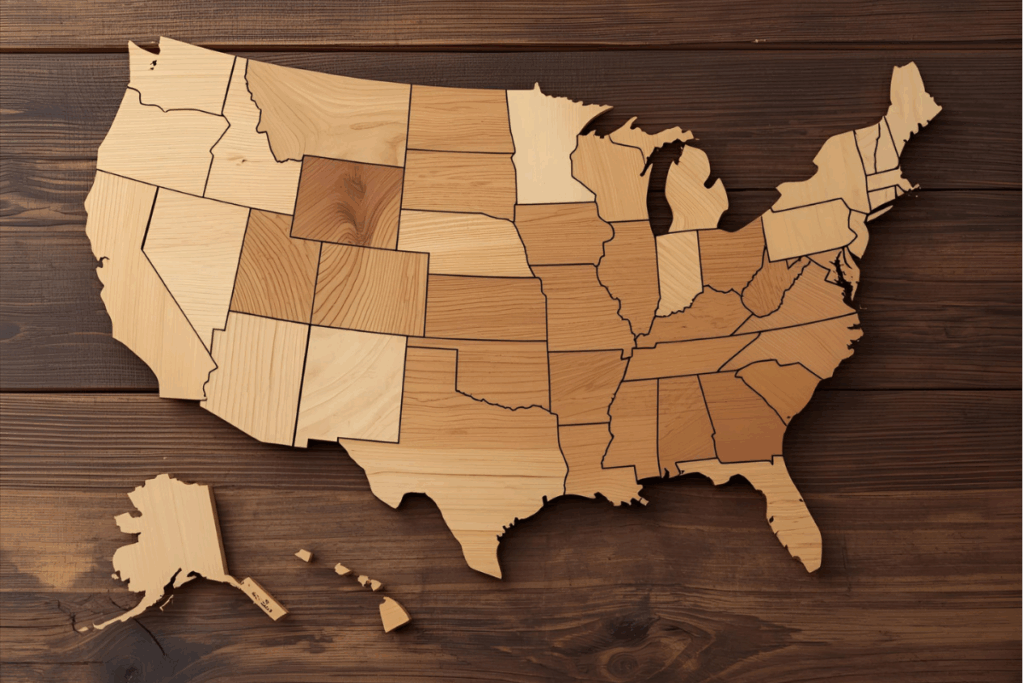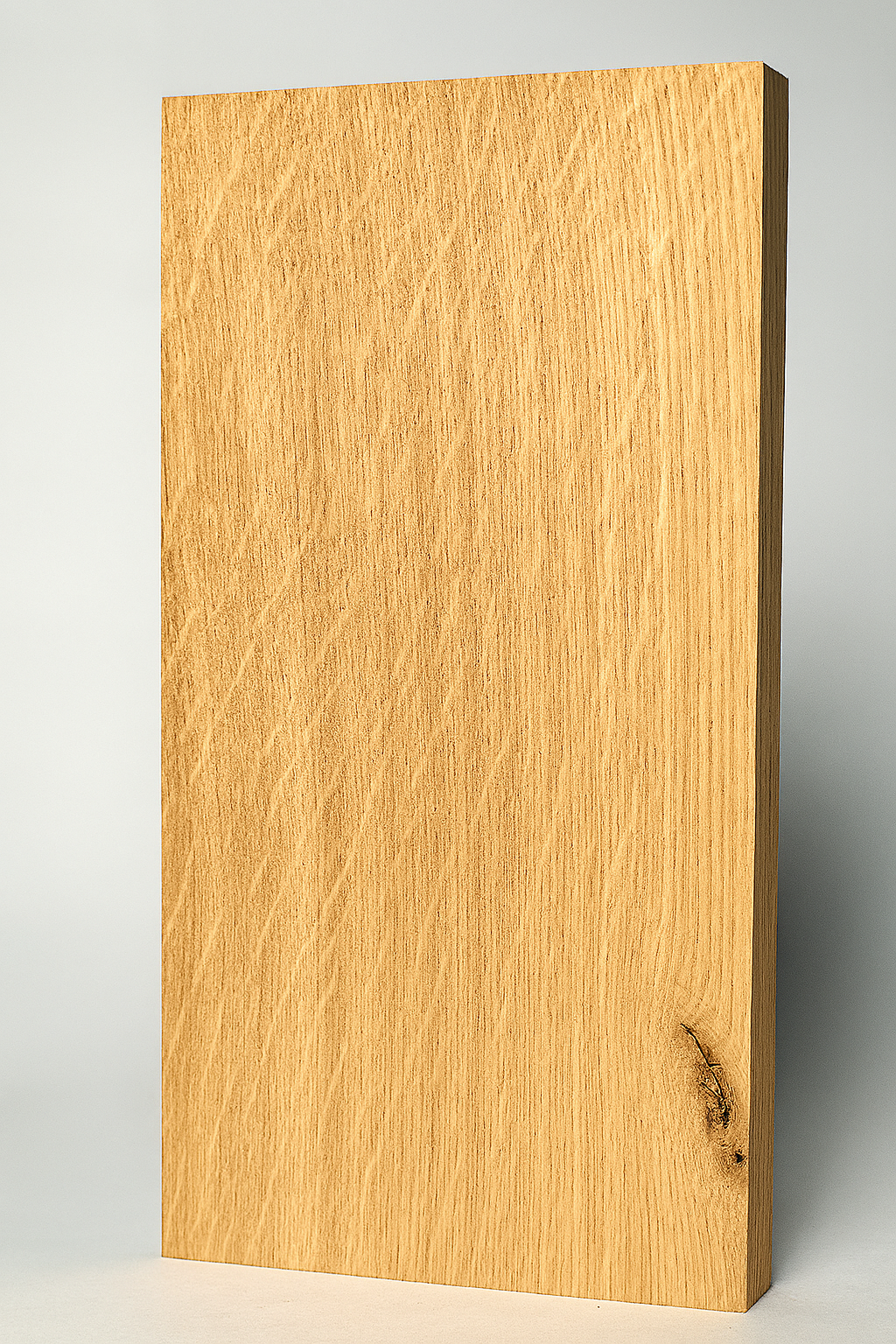White oak has long been celebrated as one of the most versatile and durable hardwoods available to builders, furniture makers, and homeowners alike. Its reputation stretches back centuries, with historical applications ranging from shipbuilding to fine cabinetry. Today, white oak continues to be a material of choice for flooring, furniture, millwork, and architectural accents. Yet, buying white oak is not as straightforward as simply choosing a species name. There are many factors—ranging from grading standards and sustainability to cost and intended use—that should be carefully weighed before making a purchase. This article explores those considerations in depth, offering a comprehensive guide for anyone looking to invest in white oak.
White Oak Price Guide
National Averages
White Oak (4/4): $9.77
White Oak (5/4): $10.63
White Oak (6/4): $11.36
White Oak (8/4): $13.13
For 2025 the national average for all grades, thickness and milling of 4/4 white oak is $9.77 and represents a slight increase from 2024. However, expect to pay more for thicker material, quartersawn, riftsawn and higher grades such as FAS.
Regional variations are also a large factor in the price of white oak, as this highly sought after wood is generally cheaper in the Midwest and most expensive in the Northeast and West.
Pricing is averaged from over 90 published price lists from retailers nationwide. Over 11,000 individual prices (all species) are behind the price averages.
My Wood Scout
Where to Buy White Oak

As most woodworkers have found, not all hardwood suppliers will sell direct to hobbyists or non-commercial woodworkers. We’ve sorted through the top retailers, and have found the following suppliers (sawmills, small hardwoods specialists and others) to be good sources of white oak hardwood for sale near you.
Midwest Region White Oak Retailers
Iowa
https://rivercityhardwoods.com
https://www.dunham-hardwoods.com
Illinois
https://www.johnsoncreekhardwoods.com
https://www.greatspirithardwoods.com
https://dougwhitehardwoods.com
Indiana
https://www.lukensqualityhardwoods.com
https://wiblesupickhardwoods.com
https://www.northwestlumberco.com
Michigan
https://www.lewislumbersales.com
http://pollumsnaturalresources.com
Minnesota
https://www.rootriverhardwoods.com
https://www.forestproductssupply.com
Montana
Ohio
http://www.homesteadhardwoods.com
Wisconsin
Northeast Region White Oak Retailers
Connecticut
https://parkervillewoodproducts.com
Maryland
Maine
New Hampshire
https://www.highlandhardwoods.com
New Jersey
https://www.willardbrothers.net
New York
https://hayleywoodproducts.com
Pennsylvania
https://www.maplestreetwoodworking.com
Virgina
South Region White Oak Retailers
West Region White Oak Retailers
Understanding White Oak
White oak (Quercus alba) is native to North America and is distinguished by its closed cellular structure, which makes it highly resistant to moisture penetration. This property is why white oak was historically used in barrels for aging wine and whiskey, as well as in shipbuilding. Its grain is typically straight, though it can display attractive variations such as ray flecks when quarter-sawn. The wood is dense, strong, and durable, with a natural resistance to rot and decay. These qualities make it suitable for both interior and exterior applications.
However, white oak is not a monolithic product. It is available in different cuts, grades, and finishes, each of which influences its appearance, performance, and price. Buyers must understand these distinctions to ensure they select the right material for their project.
The Important of Grain and Cut
One of the first considerations when buying white oak is the cut of the wood. The way a log is sawn dramatically affects the appearance of the grain and the stability of the board. Flat-sawn white oak, the most common cut, displays a cathedral grain pattern and is generally more affordable. Quarter-sawn white oak, by contrast, reveals striking ray flecks and offers superior dimensional stability, making it highly prized for fine furniture and flooring. Rift-sawn oak produces a linear grain with minimal flecking, ideal for modern, minimalist designs.
Choosing between these cuts depends on both aesthetic preference and functional requirements. Quarter-sawn boards, for example, are less prone to warping and shrinking, which makes them ideal for flooring in climates with significant humidity fluctuations. Flat-sawn boards may be sufficient for cabinetry or millwork where cost is a greater concern than dimensional stability. Understanding the differences between cuts ensures that buyers align their purchase with the demands of their project.
Grading Standards and Quality
White oak is graded according to industry standards that assess the presence of knots, defects, and overall appearance. The highest grade, often referred to as “Select” or “Prime,” features minimal imperfections and uniform color. Lower grades may include knots, mineral streaks, or color variation, which can be desirable in rustic or character-driven designs. Buyers should not assume that higher grades are always better; the choice depends on the intended aesthetic. For example, a farmhouse-style dining table may benefit from the charm of knots and irregularities, while a sleek modern cabinet may demand the clean lines of select-grade boards.
It is also important to consider consistency across a batch of lumber. Even within the same grade, boards can vary in tone and grain. When purchasing white oak for a large project, buyers should inspect multiple boards to ensure they achieve the desired uniformity or variation.
Mouisture Content and Seasoning
Moisture content is a critical factor in the performance of white oak. Wood that has not been properly dried is prone to warping, cracking, or shrinking after installation. Kiln-dried white oak is generally preferred for interior applications, as it ensures a stable moisture level suitable for conditioned environments. Air-dried oak may be acceptable for exterior projects, but buyers must confirm that the wood has been seasoned adequately to prevent future movement.
When purchasing white oak, it is wise to ask suppliers about the drying process and to measure moisture content with a meter if possible. For flooring, the recommended moisture content is typically between six and eight percent. Ensuring proper seasoning protects the investment and reduces the risk of costly repairs down the line.
Sustainability and Sourcing
In today’s market, sustainability is a growing concern. White oak is abundant in North America, but buyers should still consider the environmental impact of their purchase. Look for suppliers who source from responsibly managed forests and who can provide certification from organizations such as the Forest Stewardship Council (FSC). Certified lumber ensures that harvesting practices support long-term forest health and biodiversity.
Beyond certification, buyers may also want to consider the carbon footprint associated with transportation. Locally sourced white oak not only supports regional economies but also reduces emissions from shipping. For projects where sustainability is a priority, these factors can be as important as the quality of the wood itself.
Cost Considerations
White oak is generally more expensive than red oak, its close relative, due to its superior durability and moisture resistance. However, prices vary widely depending on grade, cut, and availability. Quarter-sawn boards, for instance, command a premium because of the labor-intensive sawing process and the distinctive grain patterns they produce. Buyers should balance their budget with their design goals, recognizing that investing in higher-quality cuts may yield long-term benefits in durability and aesthetics.
It is also worth noting that market fluctuations can affect the price of white oak. Demand from industries such as flooring and furniture manufacturing can drive prices upward, while regional supply shortages may further impact cost. Buyers planning large projects should account for potential price variability and consider purchasing in bulk to secure consistent material at a stable rate.
Applications and Suitability
The intended application of white oak plays a central role in determining what type of lumber to buy. For flooring, quarter-sawn boards are often recommended due to their stability and resistance to wear. For cabinetry, flat-sawn boards may provide the desired grain pattern at a lower cost. For outdoor projects such as decks or furniture, buyers should prioritize boards with natural resistance to decay and confirm that they have been properly seasoned.
White oak’s versatility extends to decorative applications as well. Its ability to take stain evenly makes it a favorite for designers seeking a wide range of finishes, from light natural tones to deep, rich hues. Understanding how the wood will be used ensures that buyers select the right grade, cut, and finish for their specific project.
Working Properties
Another consideration is how white oak behaves during machining and finishing. White oak is a dense hardwood, which means it can be challenging to cut and shape compared to softer species. Sharp tools and proper techniques are essential to avoid tear-out or burning. The wood’s closed grain structure also makes it less receptive to adhesives, so buyers should plan for mechanical fasteners or specialized glues when assembling projects.
On the positive side, white oak responds beautifully to finishing. Its grain accepts stains evenly, and its natural tannins can be used to create unique effects, such as fuming with ammonia to achieve a rich, aged patina. Buyers who plan to finish the wood themselves should experiment with samples to ensure they achieve the desired look.
Durabilty and Longevity
Durability is one of white oak’s defining characteristics. Its resistance to moisture and decay makes it suitable for demanding environments, from kitchens and bathrooms to outdoor furniture. However, buyers should remember that durability is not absolute. Proper maintenance, including sealing and finishing, is essential to protect the wood from prolonged exposure to moisture or UV radiation. When maintained correctly, white oak can last for generations, making it a true investment in longevity.
Matching White Oak with Design Styles
White oak’s aesthetic versatility is another reason for its popularity. In traditional designs, quarter-sawn boards with ray flecks evoke the craftsmanship of the Arts and Crafts movement. In modern interiors, rift-sawn boards provide clean, linear grain patterns that complement minimalist aesthetics. Rustic designs benefit from lower-grade boards with knots and color variation, while contemporary spaces may call for uniform select-grade lumber.
Buyers should consider how the grain, color, and finish of white oak will harmonize with their overall design vision. Consulting with designers or reviewing samples in the intended space can help ensure that the final product aligns with expectations.
Conclusion: Making an Informed Purchase
Buying white oak is not simply a matter of selecting a species; it requires careful consideration of cut, grade, moisture content, sustainability, cost, and intended application. Each of these factors influences the performance and appearance of the wood, as well as its long-term value. By understanding the nuances of white oak, buyers can make informed decisions that align with both practical needs and aesthetic goals.
Ultimately, white oak is more than just a building material. It is a timeless hardwood that embodies strength, beauty, and versatility. Whether used in flooring, furniture, or architectural accents, it offers a combination of durability and elegance that few other species can match. For those willing to invest the time and thought into selecting the right boards, white oak rewards with projects that stand the test of time.


